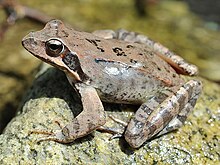Rana uenoi: Difference between revisions
m Dating maintenance tags: {{Cn}} {{Unreferenced section}} |
m citations |
||
| Line 6: | Line 6: | ||
}} |
}} |
||
'''''Rana uenoi''''' is a species of [[true frog]] that was discovered in 2014 using [[Mitochondrial DNA|mtDNA]] and comparative [[Morphology (biology)|morphology]] etc. to distinguish it from its previously designated species, [[Dybowski's frog]]. |
'''''Rana uenoi''''' is a species of [[true frog]] that was discovered in 2014 using [[Mitochondrial DNA|mtDNA]] and comparative [[Morphology (biology)|morphology]] etc. to distinguish it from its previously designated species, [[Dybowski's frog]]. It is found in wooded areas in the [[Korea|Korean Peninsula]] (it is very likely found in [[North Korea]] but the evidence is incomplete) and the nearby islands. It is also found on [[Tsushima Island]], [[Japan]].<ref name=":0" /> |
||
== Description == |
== Description == |
||
{{unreferenced section|date=July 2024}} |
{{unreferenced section|date=July 2024}} |
||
Males are smaller than females and grow to around {{cvt|5|–|6.2|cm}} [[Snout–vent length|SVL]], while females grow to around {{cvt|6|–|7.6|cm}} [[Snout–vent length|SVL]]. They are brown with striped legs and dark "temples" called [[Tympanum (anatomy)|tympana]]. They sometimes have black dots on their back. The abdomen is white and gets yellowish closer to the posterior end. Many small details distinguish ''R. uenoi'' from Dybowski's frog e.g. ''R. uenoi'' has longer [[hindlimb]]s. |
Males are smaller than females and grow to around {{cvt|5|–|6.2|cm}} [[Snout–vent length|SVL]], while females grow to around {{cvt|6|–|7.6|cm}} [[Snout–vent length|SVL]]. They are brown with striped legs and dark "temples" called [[Tympanum (anatomy)|tympana]]. They sometimes have black dots on their back. The abdomen is white and gets yellowish closer to the posterior end. Many small details distinguish ''R. uenoi'' from Dybowski's frog e.g. ''R. uenoi'' has longer [[hindlimb]]s.<ref name=":0" /> |
||
== Etymology == |
== Etymology == |
||
''Rana uenoi'' is named after Dr. Shun-ichi Uéno, a Japanese [[Entomology|entomologist]].<ref>{{Cite web |last=Matsui |first=Masafumi |date=2014 |title=Description of a New Brown Frog from Tsushima Island, Japan (Anura: Ranidae: Rana) |url=https://repository.kulib.kyoto-u.ac.jp/dspace/bitstream/2433/216901/1/zs140080.pdf |archive-url= |website=Kyoto University Research Information Repository |publisher=Zoological Society of Japan}}</ref> |
''Rana uenoi'' is named after Dr. Shun-ichi Uéno, a Japanese [[Entomology|entomologist]].<ref name=":0">{{Cite web |last=Matsui |first=Masafumi |date=2014 |title=Description of a New Brown Frog from Tsushima Island, Japan (Anura: Ranidae: Rana) |url=https://repository.kulib.kyoto-u.ac.jp/dspace/bitstream/2433/216901/1/zs140080.pdf |archive-url= |website=Kyoto University Research Information Repository |publisher=Zoological Society of Japan}}</ref> |
||
== References == |
== References == |
||
Revision as of 19:48, 1 July 2024
| Rana uenoi | |
|---|---|

| |
| Scientific classification | |
| Domain: | Eukaryota |
| Kingdom: | Animalia |
| Phylum: | Chordata |
| Class: | Amphibia |
| Order: | Anura |
| Family: | Ranidae |
| Genus: | Rana |
| Species: | R. uenoi
|
| Binomial name | |
| Rana uenoi Matsui, 2014
| |
Rana uenoi is a species of true frog that was discovered in 2014 using mtDNA and comparative morphology etc. to distinguish it from its previously designated species, Dybowski's frog. It is found in wooded areas in the Korean Peninsula (it is very likely found in North Korea but the evidence is incomplete) and the nearby islands. It is also found on Tsushima Island, Japan.[1]
Description
Males are smaller than females and grow to around 5–6.2 cm (2.0–2.4 in) SVL, while females grow to around 6–7.6 cm (2.4–3.0 in) SVL. They are brown with striped legs and dark "temples" called tympana. They sometimes have black dots on their back. The abdomen is white and gets yellowish closer to the posterior end. Many small details distinguish R. uenoi from Dybowski's frog e.g. R. uenoi has longer hindlimbs.[1]
Etymology
Rana uenoi is named after Dr. Shun-ichi Uéno, a Japanese entomologist.[1]
References
- ^ a b c Matsui, Masafumi (2014). "Description of a New Brown Frog from Tsushima Island, Japan (Anura: Ranidae: Rana)" (PDF). Kyoto University Research Information Repository. Zoological Society of Japan.
